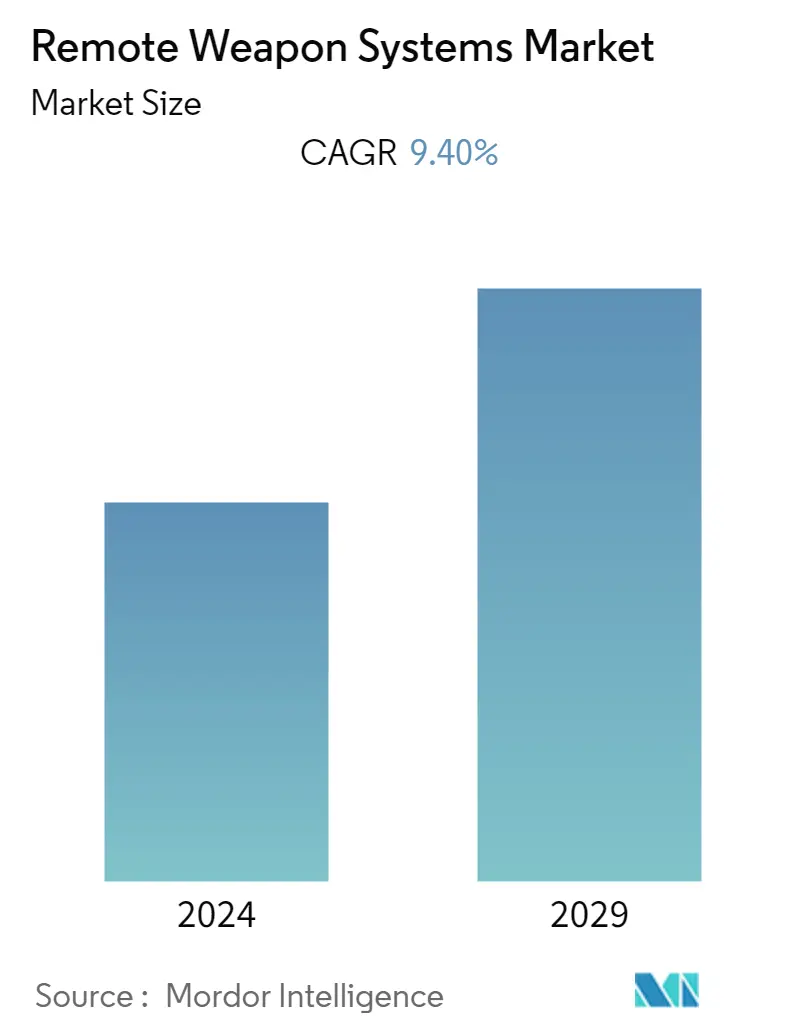Market Size of Remote Weapon Systems Industry

| Study Period | 2024 - 2029 |
| Base Year For Estimation | 2023 |
| CAGR | 9.40 % |
| Fastest Growing Market | Latin America |
| Largest Market | North America |
| Market Concentration | Low |
Major Players
*Disclaimer: Major Players sorted in no particular order |
Remote Weapon Systems Market Analysis
The Remote Weapon Systems (RWS) Market is valued at USD 9.85 billion in 2023 and is expected to reach USD 15.43 billion in 2028, registering a CAGR of 9.4% during the forecast period (2023-2028).
The use of RWS grew over the recent past, particularly driven by the growth in asymmetric warfare. Non-state actors started employing the techniques and tactics of asymmetric warfare. Conventional forces require new capabilities to become successful in modern combat situations and post-conflict scenarios. In this regard, the use of remote weapon systems is becoming widespread in several anti-terrorist and counter-insurgency operations.
There were several advancements in RWS and unmanned turrets in recent years, ranging from the protection of the systems and lethality to the support of larger calibers. Such developments are expected to help the growth in the procurement of new weapon systems and upgrades of the existing platforms in the years to come. Though RWS acts as a viable option for providing defensive firepower to the armed forces, certain installation and operational challenges are influencing the global militaries to prefer manned turrets over remote weapons. However, it is expected that these operational limitations will be addressed in the future through the extensive R&D being conducted towards the integration of advanced technologies into the RWS.
Remote Weapon Systems Industry Segmentation
A remote weapon system (RWS), also known as a remote-controlled weapon station (RCWS), is a remotely operated firearm system equipped with firing and related control systems. The RWS that are both stationary and installed on ground combat vehicles and sea and air-based combat platforms are included in the study.
The remote weapon systems market is segmented by platform and geography. By platform, the market is segmented into land (land vehicles and stationary structures), marine, and airborne. By geography, the market is segmented into North America, Europe, Asia Pacific, Latin America, and the Middle East and Africa. The market sizing and forecasts are provided in value (USD).
| Platform | ||||
| ||||
| Marine | ||||
| Airborne |
| Geography | ||||||||
| ||||||||
| ||||||||
| ||||||||
| ||||||||
| Middle East and Africa | ||||||||
| United Arab Emirates | ||||||||
| Saudi Arabia | ||||||||
| Turkey | ||||||||
| South Africa | ||||||||
| Rest of Middle East and Africa |
Remote Weapon Systems Market Size Summary
The Remote Weapon Stations (RWS) market is experiencing significant growth, driven by the increasing need for advanced capabilities in asymmetric warfare and counter-insurgency operations. The market is characterized by the widespread adoption of RWS in various military applications, including anti-terrorist operations and the protection of military bases. Recent advancements in technology have enhanced the lethality and protection of these systems, making them a viable option for modern combat scenarios. Despite some challenges related to installation and operation, ongoing research and development efforts are expected to address these issues, further boosting the adoption of RWS. The land segment, in particular, is anticipated to show robust growth due to the rising demand for stationary and mounted systems on land vehicles, driven by the need to secure vulnerable areas.
In North America, countries like the United States and Canada are leading users of remote weapon systems, focusing on upgrading their existing fleets to counter emerging threats. The market is fragmented, with numerous global and regional players such as THALES, BAE Systems, and Rheinmetall AG dominating the landscape. These companies are expanding their geographical presence by innovating new systems with advanced sensor and fire control technologies. Procurement programs and contracts, such as those awarded to Kongsberg Defence & Aerospace and Rheinmetall Systems, are expected to enhance the market's business prospects. The airborne segment currently holds the largest market share, with many countries retrofitting aircraft to include RWS, reflecting a strategic approach to maximizing existing resources.
Remote Weapon Systems Market Size - Table of Contents
-
1. MARKET DYNAMICS
-
1.1 Market Drivers
-
1.2 Market Challenges
-
1.3 Porter's Five Forces Analysis
-
1.3.1 Bargaining Power of Suppliers
-
1.3.2 Bargaining Power of Buyers/Consumers
-
1.3.3 Threat of New Entrants
-
1.3.4 Threat of Substitute Products
-
1.3.5 Intensity of Competitive Rivalry
-
-
-
2. MARKET SEGMENTATION
-
2.1 Platform
-
2.1.1 Land
-
2.1.1.1 Land Vehicles
-
2.1.1.2 Stationary Structures
-
-
2.1.2 Marine
-
2.1.3 Airborne
-
-
2.2 Geography
-
2.2.1 North America
-
2.2.1.1
-
2.2.1.2 United States
-
2.2.1.3 Canada
-
-
2.2.2 Europe
-
2.2.2.1 United Kingdom
-
2.2.2.2 France
-
2.2.2.3 Germany
-
2.2.2.4 Italy
-
2.2.2.5 Russia
-
2.2.2.6 Rest of the Europe
-
-
2.2.3 Asia-Pacific
-
2.2.3.1 China
-
2.2.3.2 India
-
2.2.3.3 Japan
-
2.2.3.4 South Korea
-
2.2.3.5 Australia
-
2.2.3.6 Rest of the Asia Pacific
-
-
2.2.4 Latin America
-
2.2.4.1 Brazil
-
2.2.4.2 Mexico
-
-
2.2.5 Middle East and Africa
-
2.2.6 United Arab Emirates
-
2.2.7 Saudi Arabia
-
2.2.8 Turkey
-
2.2.9 South Africa
-
2.2.10 Rest of Middle East and Africa
-
-
Remote Weapon Systems Market Size FAQs
What is the current Remote Weapon Systems Market size?
The Remote Weapon Systems Market is projected to register a CAGR of 9.40% during the forecast period (2024-2029)
Who are the key players in Remote Weapon Systems Market?
Rheinmetall AG, THALES, BAE Systems plc, ASELSAN A.Ş. and Leonardo S.p.A. are the major companies operating in the Remote Weapon Systems Market.

